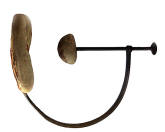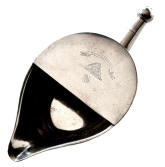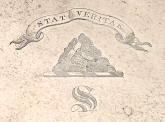15. An exceedingly rare and high-end c. 1650 English antique shagreen and silver-mounted medical case for wound care with lid and end drawer. The silver keeper and hinges are pierced and decoratively engraved. The box was made to hold small instruments (e.g., spatula, fleam, forceps. stitching quill, probe, needles, scissors, uvula spoon), lint and so-called plasters, according to texts of the times. Such a box is pictured in a painting by Gerrit Lundens (1622-c. 1677) titled Interior with Surgeon Attending to a Chest Wound, Wellcome Library, No. 44980i, and shown here. The case is right behind the surgeon and on the table. The lid and the drawer are open and some of the fancy silver-work is depicted. Several of these 17th century wound first aid instruments and plaster boxes have direct connections to The Worshipful Company of Barbers and Surgeons of London. $3,500
17. A well-made and exceedingly rare silver antique invalid feeder with the hallmarks of Charles Nephew & Company, Calcutta, c. 1860. The piece has a combination pap boat type spout at one end and an opposing feeding tube that terminates with a bulb strainer. The dam is engraved with armorial references to the Sandeman family of port wine fame: the Rock of St. Peter (the Christian Church); the motto STAT VERITAS (Truth Edures); the initial S. The antique infant feeder is probably connected to the family of William Henry Sandeman, 1820-1868, Chief Superintendent, Her Majesty's Dockyard, Kidderpore. The Sandemans had four children born in India between 1854 and 1866. Ex Elisabeth Bennion, Simon Kaye. $4,500
18. An antique dental pelican with two rounded fulcrums and a curved and a straight clawed levers. A similar tooth extracting pelican is illustrated (exaggerated and claws flattened) in Ambroise Paré, Deux Livres de Chirurgie, Paris, 1573, p. 353. Dr. Benjamin Bell so describes a figure of a pelican with a curved arm in A System of Surgery (1784) : A claw with a considerable degree of curvature, for extracting teeth at a greater depth in the mouth than the fulcrum can be placed at. Bell is referring to the molars. This is a fine example of a scarce antique tooth extracting pelican, the more rare for having a curved arm. $2,850.
.
19. An unusual silver antique 'artificial hand' style hearing aid hallmarked Charles Rawlings, London, 1824. Rawlings (1794-1863), later joined by William Summers in 1829, was an important English goldsmith. A similar ear shell antique ear trumpet, though not as high end, was used by Prime Minister William Gladstone. Another parallel is an early 20th century faux tortoiseshell example in the Wellcome Collection. The holes along the interior edge once were used to secure padding to protect the back of the user's ear. This is the earliest 'cupped-hand' hearing aid and the only one in silver known to this dealer. $4,250
20. A very rare antique sciatic nerve compressor that warranted a book of its own written by James Carrick Moore, the inventor, titled A Method of Preventing or Diminishing Pain in Several Operations of Surgery, London, 1784. Click here to read the monograph. For a brief biography of James Moore (1762-1834) and history of the James Moore tourniquet, please see this reference: Thomas Dormandy, The Worst of Evils: The Fight Against Pain, Yale, 2006. Bennion, Antique Medical Instruments, features a Moore's nerve compressor on p. 189 as the lead item to the section on anesthesia. Here is an unusual and little recognized artifact from the history of anesthesiology. The portrait of Dr. Moore is in the collection of The National Galleries of Scotland. The hefty instrument is made of iron, leather and wood. 43 cm across as picture. The larger pad is 18 x 19 cm. $6.500














